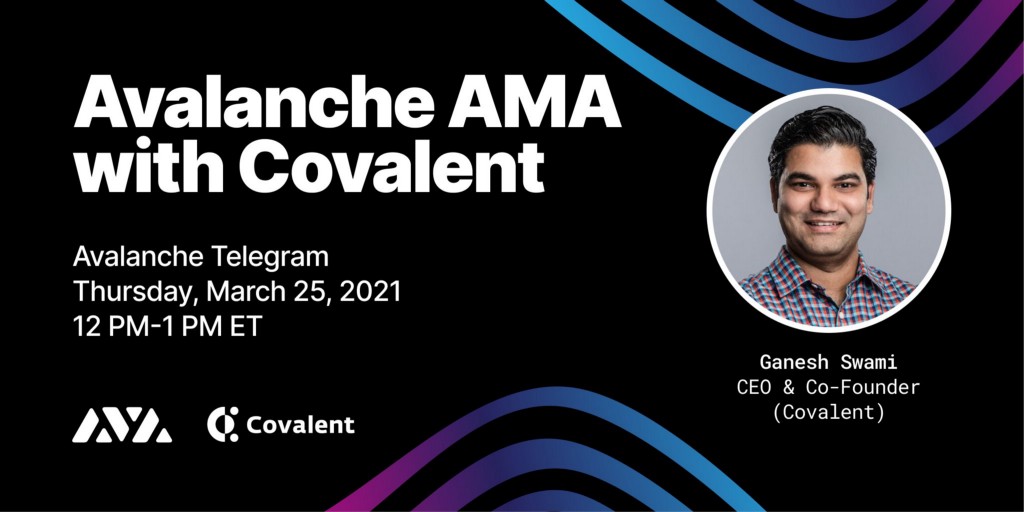Recap of Avalanche X Covalent AMA — 25th March 2021
Recap of Avalanche X Covalent AMA — 25th March 2021

Covalent, a leading provider of indexing solutions for blockchains, has integrated with Avalanche, expanding the availability of data on the platform and simplifying the experience for developers who need reliable, high-quality data.
Covalent provides a unified API to bring full transparency and visibility to assets across all blockchain networks. Its dataset supports 25B+ transactions, 30,000+ price feeds, and 200,000+ smart contracts for querying.
With the integration already completed, the rapidly growing DeFi ecosystem on Avalanche is fully indexed and available through Covalent’s APIs.
On 25th March 2021, Avalanche hosted Ganesh Swami, CEO & Co-Founder at Covalent. The Avalanche community were able to raise questions which received detailed responses from Ganesh. Listed here are some of the questions related to the integration of Covalent in Avalanche.
- How will the integration of Covalent with Avalanche benefit developers in Avalanche?
Ganesh Swami,
There are three main benefits to be working with a top notch product like Avalanche:
1) On Ethereum, we have Etherscan — but we don’t really have something like this for other blockchains. Even simple questions like “give me a list of assets in my wallet” is a difficult thing to answer — Covalent now has an API for that. So that’s powerful.
2) Covalent currently has 100+ customers including all the big names like Frontier, 0x, Zerion etc. — for these developers it’s just a matter of changing one character and now they are all supporting Avalanche. We should see a lot more activity on Avalanche in the coming months.
3) For this space to grow, we need to attract new talent and not just be focussed on the small crypto community we have today. With regards to that we will be announcing a hackathon for the Avalanche community. The magic here is that it’s designed for traditional web 2.0 developers and there are millions of those. Avalanche will be a exciting project to get their first cut at developing blockchain products.
2. Assuming that Covalent is currently a centralised service, is there any plans to make it decentralised in the future? And if so can you provide a brief overview of how that would work and estimated timelines?
Ganesh Swami,
Yes, Covalent is currently a centralized service. We built this to test the market and was the quickest way to product-market fit. Now that we have p/m fit — we are going to progressively decentralize it.
Instead of Covalent being hosted on the cloud by us — a group of validators will instead be hosting the service.
We actually just announced our new funding round yesterday to take this decentralized network to market — by some amazing investors like Coinbase, Binance, Hashed and ofcourse Ava Labs — https://www.coindesk.com/decentralized-data-project-covalent-raises-another-2m
Decentralized Data Project Covalent Raises Another $2M — CoinDesk
Covalent will used the funding to launch a decentralized version of its data query network and develop new product offerings.
3. Accessing all assets in a single place is very convenient but it usually proves to be insecure. How will you protect the end user from prying eyes? Can you give an example of a security measurement?
Ganesh Swami,
1) First, Covalent never touches your assets — we only provide data — we don’t touch your private keys or send transactions or write to the blockchain. That’s just not within the scope of what we are building.
2) Secondly, all blockchain data is public — we simply provide a more convenient API to retrieve that data.
3) Thirdly, when the decentralize network launches — customer can chose what query node they want to push towards — and ofcourse those query nodes can have legal documents to protect your privacy.
4. What are the main uses of the Covalent API and who are its main partners, how have they influenced the development of Covalent?
Ganesh Swami,
There are two main uses of Covalent:
1) Class A endpoints — that can be used to pull out balances, positions, historical transactions and smart contract events. This same API works across a dozen different blockchains and we have hundreds of teams and millions of API calls supporting this use-case, including all the top wallets and DeFi projects in the space. These APIs are best in class — I don’t think there’s another alternative that’s as powerful as Covalent today.
2) Class B endpoints — this is a little more specific to the particular blockchain. Eg: on Avalanche, it could be Pangolin APIs etc.
You can see the list of partners on our website. Partners are crucial for us to take our product out to market.
5. Can you simply explain to the avalanche community what covalent fundamentals and architecture is and how it extracts data from the blockchain?
Ganesh Swami,
Covalent is a simple architecture — developers have a simple REST api to make queries and it returns JSON responses. Behind the scenes there’s a lot of machinery to make this work — eg: making sure you are able to keep the blockchain nodes in sync, making sure you are able to copy out the data and making sure the API is consistent. There’s a lot more going on in this layer that we’ll go over at some point.
6. What is the comparative advantage of Covalent over other platforms that provide similar services?
Ganesh Swami,
The biggest competitor is The Graph. The biggest advantage of Covalent is that it offers a “no-code” solution to pulling out data. With the graph, developers need to spend days to write a subgraph. So time to market is 5 minutes with Covalent while it takes atleast 20 hours with the graph.
The second advantage is that the same API on Covalent works on multiple blockchains — while the graph each blockchain is different.
7. Covalent expands the availability of data on the platform. How is this data accurate and secure all the time? How do you ensure all these sources are reliable?
Ganesh Swami,
Great question — this was the challenge with the centralized version — you had to trust Covalent. With the decentralized version, the network has slashing to make sure the data is accurate and reliable and there’s no corruption either maliciously or accidentally.
8. Where does the project name come from? What does it mean for you and why did you choose that name for your project?
Ganesh Swami,
The project name “Covalent” comes from Chemistry. Covalent bonds are a special kind of bond in Chemistry — and it’s in line with our vision that we “bond” the current centralized world with the future decentralized world
9. Can you describe your groundbreaking Covalent partnership with Avalanche? How does this partnership help grow your platform? What are the win-win benefits of this collaboration?
Ganesh Swami,
The partnership with Avalanche is pretty exciting — the first I’m most excited about is the credible scaling benefits Avalanche brings to the table. It’s a win-win because developers on Avalanche get access to a sophisticated set of APIs and the benefit to Covalent is that we get more and more use-cases being explored that helps us build better APIs.
10. Can you talk more about the covalent future plan? What are the benefits your project might bring in the long run to Avalanche?
The long term plan for Covalent is build the decentralized network so that the infrastructure becomes unstoppable.
The short term plan is an exciting hackathon ‘One Million Wallets’ that we will be announcing exclusively for the Avalanche community. It runs April 6–19 with registration opening next!
Lots of prizes, quizzes, competitions — so folks stay tuned! Looking forward to this hackaton !
About Covalent
Covalent leverages big-data technologies to create meaning from hundreds of billions of data points, delivering actionable insights to investors and allowing developers to allocate resources to higher-utility goals within their organization. Instead of pain-stakingly sourcing data from a small handful of chains, Covalent aggregates information from across dozens of sources including nodes, chains and data feeds. The Covalent API then sources end users with individualized data by wallet, including current and historical investment performance across all types of digital assets. Most importantly, Covalent returns this data in a rapid and consistent manner, incorporating all relevant data within one API interface.
About Avalanche
Avalanche is an open-source platform for launching decentralized finance applications and enterprise blockchain deployments in one interoperable, highly scalable ecosystem. Developers who build on Avalanche can easily create powerful, reliable, and secure applications and custom blockchain networks with complex rulesets or build on existing private or public subnets.
Website | Whitepapers | Twitter | Discord | GitHub | Documentation | Forum | Avalanche-X | Telegram | Facebook | LinkedIn | Reddit | YouTube
![]()
Recap of Avalanche X Covalent AMA — 25th March 2021 was originally published in Avalanche Hub on Medium, where people are continuing the conversation by highlighting and responding to this story.

